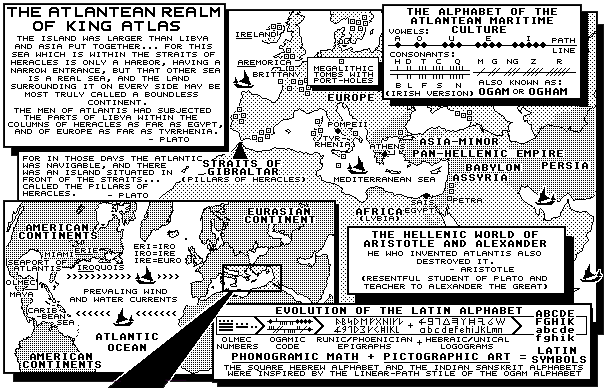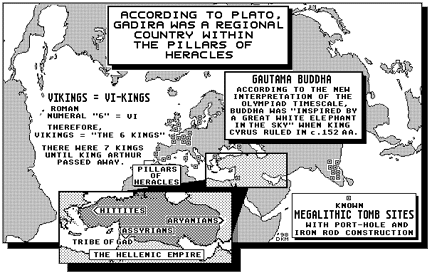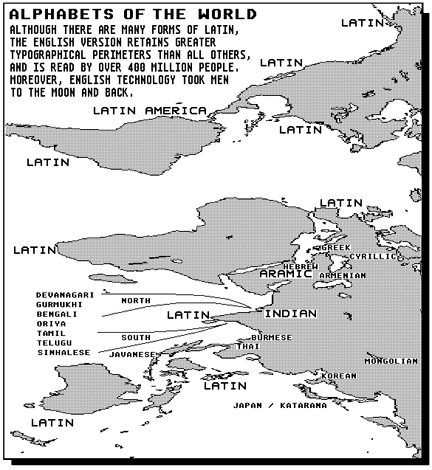
This view of the Atlantean realm includes the maritime parameters of the lost civilization before the Biblical flood. Also included is how the forgotten binary alphabet of the Atlanteans evolved into the Latin alphabet over many generations.

This view of the Atlantean realm includes the
maritime parameters of the lost civilization before the Biblical
flood. Also included is how the forgotten binary alphabet of the
Atlanteans evolved into the Latin alphabet over many generations.
1/ While the pictographic alphabet of the Aeolian culture was
laying the foundation to Western Society, Semitic merchants of
the Phoenician region were also adapting the lineal efficiency of
the new phonetic style of writing from the west and developed
Canaanite and Aramaic chirography.
(The Hittites of Asia Minor also replicated the paragraphical
method of phonetic communication but failed to established a
right or left handed format of standard reading and spelling -
which probably led to many confused interpretations of recorded
information that resulted in major political disagreements among
regional kingdoms)
2/ With the advent of papyrus paper from reed stalks by the
"reed sea" in Egypt - and the purple inks from the
murex shellfish discovered by the Phoenicians, the Assyrians, the
Babylonians and even the Aryan tribes were now reading and
writing information in paragraphical scripture.
(Merchants selling indigo dye or any long-lasting purple ink were
referred to as "indians" by European traders)
3/ The Vedic Sanskrit alphabet of ancient India was perhaps
the result of an alphabetical "compromise" between the
paragraphical style of writing brought by the Aryan occupation of
southwest Asia and the oriental pictographic statements brought
by traders from the Far East.
(Notice how the main path line of the Ogamic, Hebraic and
Sanskrit alphabets provide an easy linear track system for
phonogramic information and realize which alphabet came first)
4/ While the Aryan tribes were marching eastwards the Assyrians took to the west and converted much of the Egyptian hieroglyphics into the cursive demotic style of writing.
5/ Meantime, in the northern part of the Middle East, the
Hittites of Asia Minor also launched a military invasion toward
the west, but were defeated by retaliating waves of Grecian
tribes known, in part, as "the Sea Peoples".
(The Grecian tribes of the Aegean realm contested the Hellenic
forces from Asia Minor when King Darius of Persia attempted to
annex the region from the east - resulting in the infamous
"Persian Wars")

The rebellious Hellenic Empire.
For there was a time, Solon, before the great deluge of all, when the city which is now Athens was first in war... She was
preeminent in courage and military skill, and was leader of the Hellenes.
- Timaeus Dialogue / 23.c;25.c / Plato
7/ Because this new Ionic alphabet was able to record
paragraphical information like never before, democratic elections
became possible for the first time due to a more comprehensible
format of political literature.
(It was also at this time in Greek history that Plato created the
first academy of the arts and sciences - which collectively
transcribed from old alphabetical formats into books many
international stories from abroad, such as the famous legend
about Atlantis and its maritime kingdom)
[The notable Rosetta Stone illustrates three of the aforesaid
alphabets in use within the eastern Mediterranean realm at that
time]
8/ By the time this new Ionic alphabet made its way into
Gothic Europe, it was altered into an orthographic set of letters
known as the Runic alphabet.
(Much of our Norse mythology was recorded from Runic poetry found
inscribed, like Ogam once was, on old wooden logs)
[In Norse mythology, there existed a heavenly city far to the
west called Asgard where princess Freya could fly with the help
of her "winged dress"]
9/ To prevent spelling problems, the "rule to the
right" was adopted throughout most of Europe shortly after
the Roman Empire - and its Latinized alphabet, reached its
maximum range.
(The Cyrillic alphabet from the Byzantine part of the Roman
Empire also used the "rule to the right" concept - even
transcibing some letters in "reverse", such as the
letters "R", "N" and sometime "E")
10/ With the fall of the Roman Empire, Anglo-Saxon merchants,
together with other European scholars, initiated an upper and
lower case alphabet in which Runic letters from Gothic Europe
were united with uncial symbols from southern Europe and began
the foundation to what is known as Old English.
(Many now believe that the fall of the Roman Empire can be traced
directly to lead poisoning - whereby because the Romans were
ignorant of how lead can slowly accumulate in the body from use
of lead plumbing and, as a result, political leaders who were
afflicted made poor judgments about governmental priorities which
in turned caused disharmony and revolution)
11/ Because of the general desire to more efficiently express phonetical messages in literary terms, and due to the scriptorium facilities of Christian churches, this upper and lower case Latin alphabet was adopted by most European merchants by the time Columbus set sail across the Atlantic.

Alphabets of the world.
The Anglo-Saxon peoples of northern Europe may have invented the alphabetical rules of English,
but the English vocabulary was developed over many generations throughout the world.

English and the high ground.
Of all known languages, English is the only one to be spoken on the moon.